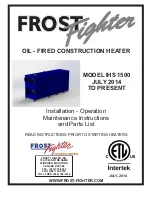
TM049 27L Continuous Flow Service Instructions
REV AL
– Issued April 2019
This document is stored and maintained electronically by Rheem Technical Support.
All printed copies are deemed “uncontrolled”.
5
Touch Voltage Testing
Under certain fault conditions it is possible for the
metal jacket of a water heater to become live.
The electrical fault may be an internal appliance
issue or an issue with the building supply wiring
(see diagram 1 opposite).
To check for a shock hazard in a suspect
installation a
Touch Voltage Test
must be
applied using the following equipment:
1. A high impedance multimeter with an
input impedance greater than 5 mega-
ohm.
2. A 2k
Ω resistor box fitted with contact
terminals.
3. A long trailing lead for connection to
the premises earth electrode.
Note: The 2k
Ω resistor is used to simulate
the body resistance of a typical person.
Diagram 2
Procedure:
Personal Protective Equipment (electrical insulating gloves) should be
worn when conducting this procedure to reduce the risk of electric shock.
1. Connect the resistance box between the metal casing of the appliance and the main
Earth electrode (Spike) using the long trailing lead (as shown in diagram 2).
2. Connect the multimeter (set on the AC volts scale) to the resistor box terminals and
record the reading.
3. If the reading is higher than 50VAC (Dry) or 25VAC (Wet) then there is a fault either
within the electrical installation or with the appliance.
4. To confirm the earthing of the water heater;
Electrically isolate the appliance from the electrical circuit.
Conduct an earth continuity test to AS/NZS 3760 (pay particular attention to the
cordset earth on plug in water heaters).
If the earth path of the appliance is intact, the problem is with the household wiring.
Diagram 1






































